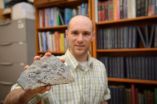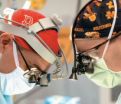Cereal flake size influences calorie intake
2014-03-26
(Press-News.org) People eat more breakfast cereal, by weight, when flake size is reduced, according to Penn State researchers, who showed that when flakes are reduced by crushing, people pour a smaller volume of cereal into their bowls, but still take a greater amount by weight and calories.
"People have a really hard time judging appropriate portions," said Barbara Rolls, professor of nutritional sciences and Helen A. Guthrie Chair in Nutrition. "On top of that you have these huge variations in volume that are due to the physical characteristics of foods, such as the size of individual pieces, aeration and how things pile up in a bowl. That adds another dimension to the difficulty of knowing how much to take and eat."
According to Rolls, national dietary guidelines define recommended amounts of most food groups in terms of measures of volume such as cups.
"This can be a problem because, for most foods, the recommended amounts have not been adjusted for variations in physical properties that affect volume, such as aeration, cooking, and the size and shape of individual pieces." Rolls said. "The food weight and energy required to fill a given volume can vary, and this variation in the energy content of recommended amounts could be a challenge to the maintenance of energy balance."
The researchers tested the influence of food volume on calorie intake by systematically reducing the flake size of a breakfast cereal with a rolling pin so that the cereal was more compact and the same weight filled a smaller volume. In a crossover design, the team recruited 41 adults to eat cereal for breakfast once a week for four weeks. The cereal was either standard wheat flakes or the same cereal crushed to reduce the volume to 80 percent, 60 percent or 40 percent of the standard. The researchers provided a constant weight of cereal in an opaque container and participants poured the amount they wanted into a bowl, added fat-free milk and non-calorie sweetener as desired and consumed as much as they wanted.
The researchers reported their results in the current issue of the Journal of the Academy of Nutrition and Dietetics.
The research showed that as flake size was reduced, subjects poured a smaller volume of cereal, but still took a significantly greater amount by weight and energy content. Despite these differences, subjects estimated that they had taken a similar number of calories of all versions of the cereal. They ate most of the cereal they took, so as flake size was reduced, breakfast energy intake increased.
"When faced with decreasing volumes of cereal, the people took less cereal," Rolls said. "Yet, even though they thought they were taking the same number of calories, they ended up significantly overeating."
According to Rolls, the findings of the study have implications for both portion selection and dietary advice. National guidelines for most food groups define recommended amounts in terms of volume, such as cups, but only a few adjustments are made for differences in food volume stemming from physical properties of food, she said. Rolls's 2012 book "The Ultimate Volumetrics Diet," offers readers practical tips on how to use variations in food volume to manage their calories and body weight. The book is based on her decades of research, which shows that lowering the calorie density -- or calories per bite -- of food can help people feel full while eating fewer calories.
"There are a lot of variations in food volume that we're not given much advice about," Rolls said. "Our research shows clearly that, without us even knowing it, these variations can have a big impact on how much we're eating. For cereals with small pieces, the recommended serving size should be reduced to account for the uncharacteristically low volume, in the same way that the recommended serving size is increased for voluminous foods, such as puffed cereals and leafy greens."
INFORMATION:Other authors on the paper include Jennifer Meengs, laboratory manager in nutritional sciences, and Liane Roe, research nutritionist in nutritional sciences.
The National Institutes of Health supported this research.
ELSE PRESS RELEASES FROM THIS DATE:
Kif15: The acrobatic motor protein that could pave the way for new cancer therapies
2014-03-26
Researchers at Warwick Medical School have shown for the first time how a protein motor, Kif15, uses acrobatic flexibility to navigate within the mitotic spindle. Understanding how it works could prove vital for the development of targeted cancer therapies.
The new study, published in eLife, describes the behaviour of Kif15 for the first time and provides a breakthrough step towards understanding the role it plays in cell division.
Many frontline cancer drugs target microtubules, the molecular cables that are used to build the mitotic spindle - the protein machine that ...
Parental addictions associated with adult children's arthritis
2014-03-26
The adult offspring of parents who were addicted to drugs or alcohol are more likely to have arthritis, according to a new study by University of Toronto researchers.
Investigators examined a group of 13,036 adults and found that 20.4 per cent of respondents had been diagnosed with arthritis by a medical professional. Investigators found that 14.5 per cent of all respondents reported having at least one parent whose drug or alcohol use caused problems while were under the age of 18 and still living at home.
Results indicate that individuals whose parents were addicted ...
Study finds secret to cutting sugary drink use by teens
2014-03-26
COLUMBUS, Ohio – A new study shows that teenagers can be persuaded to cut back on sugary soft drinks – especially with a little help from their friends.
A 30-day challenge encouraging teens to reduce sugar-sweetened drink use lowered their overall consumption substantially and increased by two-thirds the percentage of high-school students who shunned sugary drinks altogether.
The "Sodabriety" challenge, piloted by Ohio State University researchers, was an effort to confront the largest source of added sugar in the U.S. diet: sugar-sweetened soft drinks, sports and energy ...
Scientists track 3D nanoscale changes in rechargeable battery material during operation
2014-03-26
UPTON, NY-Scientists at the U.S. Department of Energy's Brookhaven National Laboratory have made the first 3D observations of how the structure of a lithium-ion battery anode evolves at the nanoscale in a real battery cell as it discharges and recharges. The details of this research, described in a paper published in Angewandte Chemie, could point to new ways to engineer battery materials to increase the capacity and lifetime of rechargeable batteries.
"This work offers a direct way to look inside the electrochemical reaction of batteries at the nanoscale to better understand ...
New clue to autism found inside brain cells
2014-03-26
The problems people with autism have with memory formation, higher-level thinking and social interactions may be partially attributable to the activity of receptors inside brain cells, researchers at Washington University School of Medicine in St. Louis have learned.
Scientists were already aware that the type of receptor in question was a potential contributor to these problems – when located on the surfaces of brain cells. Until now, though, the role of the same type of receptor located inside the cell had gone unrecognized. Such receptors inside cells significantly ...
Counting calories in the fossil record
2014-03-26
Starting about 250 million years ago, at the end of the Permian period, brachiopod groups disappeared in large numbers, along with 90 percent of the planet's species. Today, only a few groups, or genera, of brachiopods remain. "Most people won't be familiar with brachiopods. They're pretty rare in the modern ocean," said Jonathan Payne, a paleobiologist at Stanford University.
Meanwhile, bivalves flourished, diversifying into a staggering variety of shapes and sizes, and spread from marine to freshwater habitats. "After the end-Permian mass extinction, we find far fewer ...
Last drinks: Brain's mechanism knows when to stop
2014-03-26
The study found a 'stop mechanism' that determined brain signals telling the individual to stop drinking water when no longer thirsty, and the brain effects of drinking more water than required.
Researcher Professor Derek Denton from the Faculty of Medicine, Dentistry and Health Sciences at the University of Melbourne said the study provided insight into the human instincts that determine survival behaviour and are also of medical importance.
"Different areas of the brain involved in emotional decision-making were activated when people drank water after becoming ...
Two spine surgeons are 3 times safer than 1
2014-03-26
Seattle, WA—A new team approach has improved safety—reducing rates of major complications by two thirds—for complex spinal reconstructive surgery for spinal deformity in adult Group Health patients at Virginia Mason Hospital & Seattle Medical Center. An article in the March issue of Spine Deformity gives a detailed description of the standardized protocol before, during, and after the surgery, stressing the new approach's three main features:
Two spine surgeons in the operating room
A live preoperative screening conference
Monitoring bleeding during the operation
The ...
ATHENA desktop human 'body' could reduce need for animal drug tests
2014-03-26
Creating surrogate human organs, coupled with insights from highly sensitive mass spectrometry technologies, a new project is on the brink of revolutionizing the way we screen new drugs and toxic agents.
ATHENA, the Advanced Tissue-engineered Human Ectypal Network Analyzer project team, is developing four human organ constructs – liver, heart, lung and kidney – that are based on a significantly miniaturized platform. Each organ component will be about the size of a smartphone screen, and the whole ATHENA "body" of interconnected organs would fit neatly on a desk.
"By ...
Life expectancy gains elude overweight teens
2014-03-26
Washington, DC—Although people live longer today than they did 50 years ago, people who were overweight and obese as teenagers aren't experiencing the same gains as other segments of the population, according to a new study published in the Endocrine Society's Journal of Clinical Endocrinology & Metabolism (JCEM).
The life expectancy of the average American born in 2011 was 78.7 years, according to the U.S. Centers for Disease Control and Prevention. The average lifespan has increased by more than a decade since 1950, but rising obesity rates threaten to take a toll on ...







